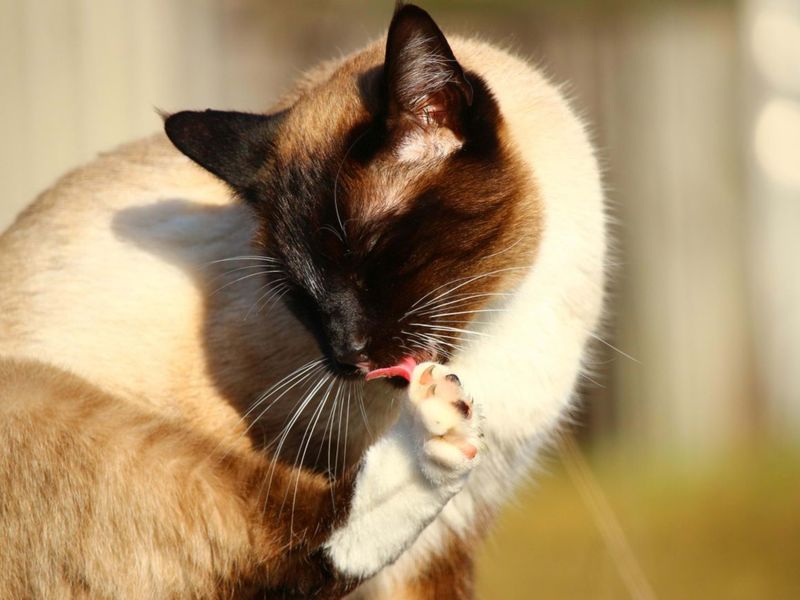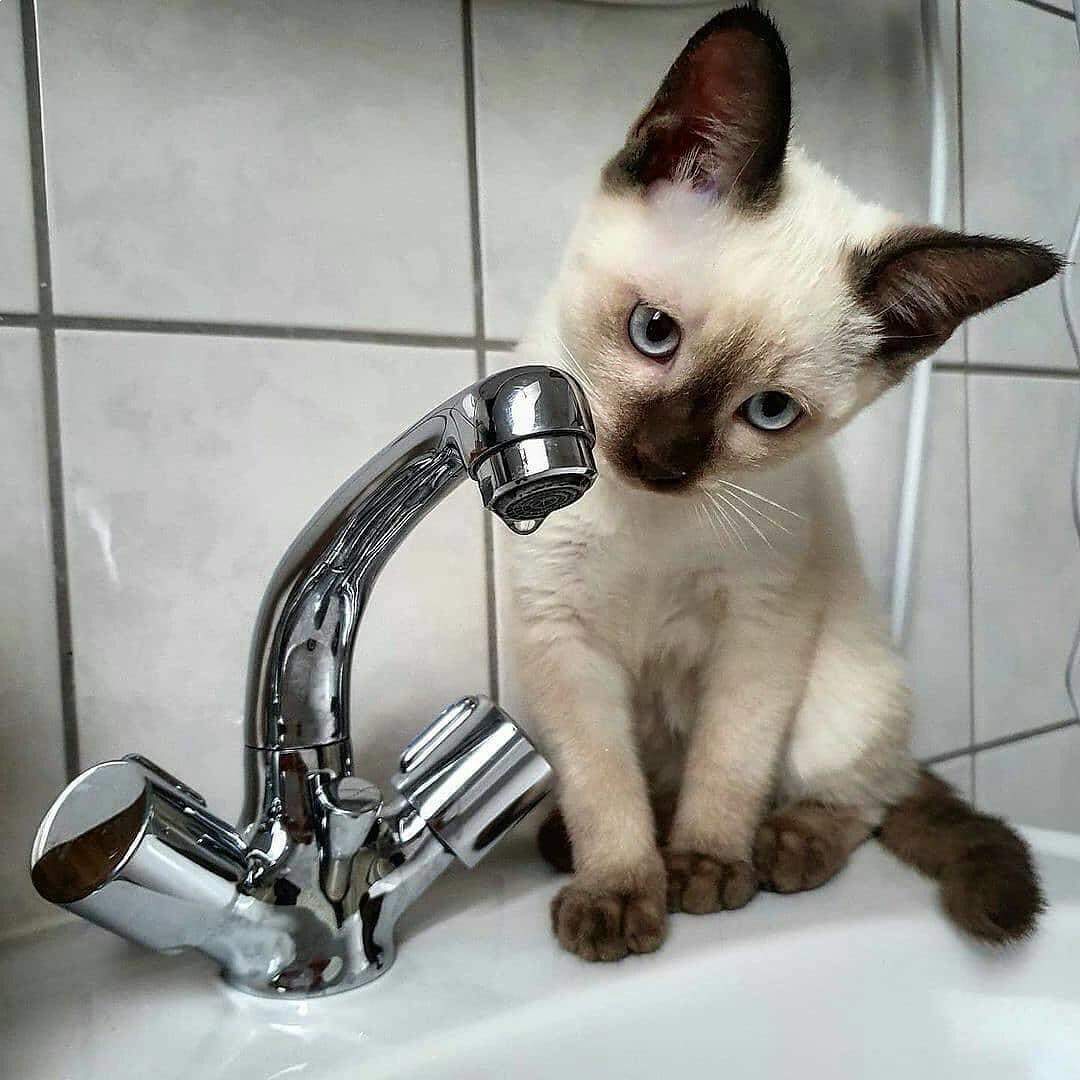📖 Table of Content:
- 1. Excessive Vocalization
- 2. Separation Anxiety
- 3. Aggression Towards Other Pets
- 4. Territorial Urination
- 5. Obsession with Climbing
- 6. Overgrooming
- 7. Food Aggression
- 8. Nighttime Activity
- 9. Fear of Strangers
- 10. Begging for Attention
- 11. Scratching Furniture
- 12. Stealing Food
- 13. Hiding and Isolation
- 14. Jumping on Countertops
- 15. Obsession with Water
Siamese cats are recognized for their intelligence, vocal nature, and strong personalities. These cats are often affectionate and form strong bonds with their owners, making them cherished companions. However, their distinctive traits can sometimes lead to behavior challenges that require attention and understanding.
Despite their loving nature, Siamese cats may display certain behavior problems that can be difficult for owners to navigate. These issues can range from excessive vocalization to territorial tendencies, all influenced by their unique personalities. Recognizing these behaviors early can help prevent frustration and improve the bond between owner and cat.
Whether a new Siamese cat owner or someone with years of experience, knowing how to address these behavior problems can lead to a more harmonious relationship. By understanding the root causes of these behaviors, solutions can be found that benefit both the cat and its human family. With the right approach, the joys of owning a Siamese cat far outweigh the challenges.
1. Excessive Vocalization
Siamese cats are famously vocal, often expressing themselves loudly and frequently. This trait, while endearing to some, can become overwhelming, especially if the cat meows incessantly throughout the night. Understanding the reasons for their vocalization is key. Often, they meow to communicate needs, seek attention, or express discomfort.
Providing stimulating toys or interactive playtime can help keep them entertained and reduce excessive meowing. Additionally, ensuring they are fed and comfortable before bedtime may alleviate nighttime vocalization. By acknowledging their needs and offering solutions, owners can enjoy more peaceful interactions.
2. Separation Anxiety
Due to their affectionate and sociable nature, Siamese cats can experience separation anxiety when left by themselves for extended periods. Their strong bond with their owners makes being alone a stressful experience for them. Signs of this anxiety include excessive meowing, destructive actions, and a lack of appetite.
To alleviate anxiety, consider gradual desensitization techniques, leaving for short intervals and gradually extending the time apart. Interactive toys or puzzles can also keep them occupied. Creating a safe, cozy space with familiar scents may comfort them during absences. Understanding and addressing separation anxiety ensures a happier, more relaxed feline companion.
3. Aggression Towards Other Pets
Territorial instincts or fear can cause Siamese cats to act aggressively toward other pets. This may show as hissing, swatting, or chasing, making it essential to approach introductions carefully. By offering separate spaces and resources, such as designated food bowls and litter boxes, owners can ease tensions and prevent stress.
Additionally, using calming pheromone diffusers may create a more peaceful environment. Patience and understanding are crucial during the adjustment period. By fostering positive interactions and ensuring each pet feels secure, harmonious coexistence is achievable, enhancing the household dynamic.
4. Territorial Urination
Many Siamese cats struggle with territorial urination, particularly when there are changes in their environment. This behavior, where cats urinate outside the litter box, is a way of marking their territory and often signals stress or insecurity. Pinpointing the root cause, like the arrival of a new pet or changes in the home, can help resolve the issue.
Ensuring multiple clean litter boxes and keeping their environment stable can help alleviate this behavior. Additionally, using enzymatic cleaners removes scent traces, discouraging repeat occurrences. Understanding their need for security allows owners to adapt to their surroundings, fostering a comfortable and stress-free environment.
5. Obsession with Climbing
Known for their curiosity, Siamese cats are skilled climbers, often scaling furniture or shelves with ease. Though this behavior is instinctual, it can be troublesome in homes with delicate or breakable items. Providing alternatives like cat trees or shelves helps fulfill their climbing urges and protects your belongings.
Encouraging safe climbing through positive reinforcement and interactive play can deter them from unsuitable areas. By channeling their energy into appropriate outlets, owners can prevent potential accidents and damage. This proactive approach enhances the cat’s well-being and reduces household stress, ensuring a harmonious living space.
6. Overgrooming
Overgrooming in Siamese cats often results from stress, anxiety, or underlying health issues. This behavior leads to bald patches and skin irritations, causing discomfort. Identifying triggers such as environmental changes or boredom is crucial.
Offering mental stimulation through toys, interactive play, and puzzle feeders can alleviate stress. Additionally, consulting a veterinarian helps rule out medical concerns. Ensuring a stable and enriching environment promotes their well-being and reduces overgrooming incidents. By addressing the root causes, owners can ensure their cat remains healthy, comfortable, and content, fostering a loving and peaceful home environment.
7. Food Aggression
When Siamese cats exhibit food aggression, they may growl, hiss, or swat during mealtime. This behavior often arises from anxiety about food scarcity or competition. A routine feeding schedule and separate feeding zones for multiple pets can help ease this aggression.
Gradual desensitization techniques, such as hand-feeding small amounts, build trust and reduce anxiety. Positive reinforcement encourages calm behavior around food. By understanding their instincts and providing a secure feeding environment, owners can cultivate positive mealtime experiences. This approach promotes a healthier relationship with food and enhances the cat’s overall well-being.
8. Nighttime Activity
With their nocturnal nature, Siamese cats tend to play and explore during the night. This behavior may cause disruptions in the household’s sleep pattern. To manage this, providing ample playtime and stimulation during the day, along with puzzle feeders or toys, can keep them entertained at night.
Creating a cozy sleeping area may encourage longer rest periods. Adjusting the cat’s schedule to align more closely with the household can improve sleep for everyone. By understanding their natural rhythms and adapting routines, owners can achieve a more balanced and restful environment for all.
9. Fear of Strangers
When guests visit, Siamese cats may hide or retreat, displaying fear of strangers. This behavior is linked to their natural cautiousness and need for a sense of security. Slowly introducing new people and encouraging interaction with treats or toys can help the cat feel more confident and form positive connections.
Providing a safe, quiet space for escape ensures comfort during social gatherings. Patience is key, as forcing interactions may exacerbate fear. By respecting their boundaries and offering gentle encouragement, owners can help their cat become more sociable, fostering a welcoming and friendly atmosphere.
10. Begging for Attention
Due to their affectionate nature, Siamese cats often demand attention, interrupting work or leisure activities. They seek companionship and interaction, making them prone to such behaviors. Setting aside regular play or cuddle sessions, along with redirecting their focus with engaging activities, can prevent these interruptions.
Training them to understand boundaries with positive reinforcement fosters independence. By balancing attention and independence, owners can nurture a happy and well-adjusted pet. Understanding their social needs ensures a harmonious relationship, enhancing the bond between the cat and the owner.
11. Scratching Furniture
Scratching is a natural behavior for Siamese cats, helping them stretch and mark territory. However, it can lead to damaged furniture if not properly managed. Providing scratching posts or pads in key areas redirects this instinct. Positive reinforcement when using designated scratching areas encourages appropriate behavior.
Using deterrents like double-sided tape on furniture can further prevent damage. Regularly trimming their claws reduces the potential for harm. By accommodating their needs and guiding their actions, owners can protect their belongings while respecting their cat’s natural instincts, fostering a balanced and peaceful coexistence.
12. Stealing Food
With their clever and curious nature, Siamese cats are prone to stealing food from counters or tables. The irresistible aroma of human meals often triggers this behavior. To reduce food theft, keep meals out of their reach and make sure they are fed regularly to curb their cravings.
Training them with commands and rewards can discourage stealing. Providing stimulating toys or puzzle feeders satisfies their adventurous spirit. By understanding their curiosity and setting clear boundaries, owners can prevent sneaky behavior. This approach fosters a respectful dining environment and enhances trust, ensuring a harmonious household dynamic.
13. Hiding and Isolation
If your Siamese cat retreats into hiding, it could mean they’re feeling fearful, stressed, or unwell, looking for a safe escape. Loud noises or changes in their environment can trigger this behavior, but understanding the cause is the first step to helping them. By offering them peaceful hideaways and rewarding their courage with treats, you can create a positive path back to feeling secure.
Consulting a veterinarian ensures underlying health issues are ruled out. By understanding their need for security and offering reassurance, owners can encourage more social behavior, fostering a safe and welcoming home environment.
14. Jumping on Countertops
Curiosity and the desire to explore often prompt Siamese cats to jump on countertops. Though it’s a natural behavior, it can result in accidents and hygiene issues. Offering height alternatives, such as cat trees or window perches, can satisfy this instinct. Additionally, using motion-activated sprays as a deterrent can help curb the behavior.
Keeping counters free of food and clutter reduces temptation. By understanding their instincts and creating suitable exploration areas, owners can redirect behavior positively. This approach ensures a safe and clean environment, balancing curiosity with household harmony.
15. Obsession with Water
A common behavior in Siamese cats is their attraction to water, with many of them pawing at faucets or playing in sinks. Though it can be entertaining, it can result in water waste and messes. Offering dedicated water play spaces or toys can keep them engaged safely. Additionally, ensure faucets are properly closed to prevent unintended floods.
Encouraging play with water-safe toys directs their enthusiasm constructively. By acknowledging their playful nature and offering suitable alternatives, owners can enjoy their antics without household disruptions. This understanding fosters a fun and engaging environment, enhancing the bond with their feline companion.















